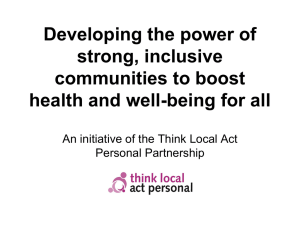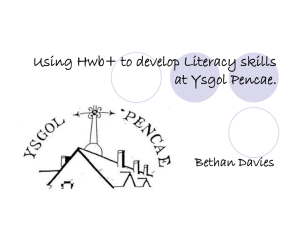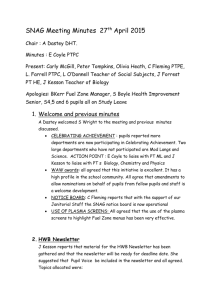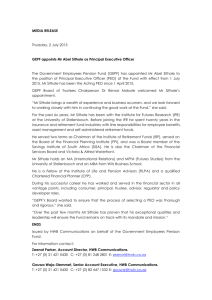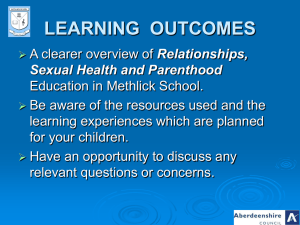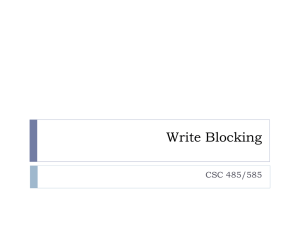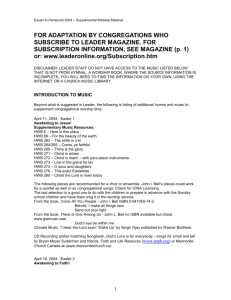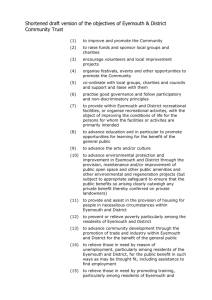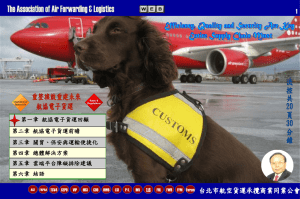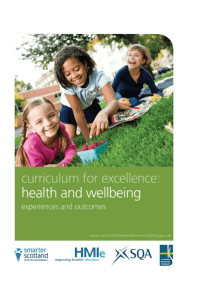Youth Work and Schools - Community Learning and Development
advertisement
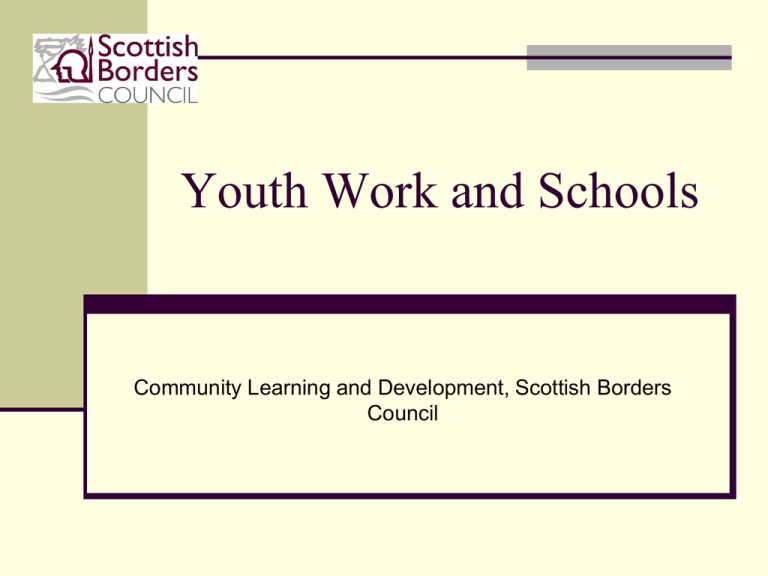
Youth Work and Schools Community Learning and Development, Scottish Borders Council Youth Work and Schools National Drivers Curriculum for Excellence Provides a common language for schools, community learning & development and other educators to work together to provide positive outcomes for young people Developing the 4 capacities, Successful learners; Confident individuals; Responsible citizens; Effective contributors. Responsibility of ALL practitioners – Health & Wellbeing, Literacy across learning, Numeracy across learning Experiences & outcomes – used to plan and deliver Youth Work & Schools courses 16+ Learning Choices Government’s model for supporting the senior phase of C for E Demands multi agency collaboration: CL&D identified as key partners HMIE New Inspection Model Use of partnership working and how this can positively impact on young peoples’ learning HMIE – Improving Scottish Education (2005-2008) “School efforts are extended by activities offered by Community Learning & Development providers.” Youth Work and Schools Other national drivers informing our work: Getting it Right for Every Child (GIRFEC) Puts children& young people at the centre of service delivery Moving forward – National Youth Work Strategy Strategy for improving young people’s chances through youth work More Choices, More Chances Action plan to reduce the number of young people not in education, employment or training Amazing Things 2 Guide to Youth Awards in Scotland – development of ‘the whole child’ Bridging the Gap Strategy detailing the benefits of school and youth work partnerships Youth Work and Schools Taking forward Youth Work and Schools in the Scottish Borders 2 pilot projects 2009 (Hawick High School & Peebles High School) CLD service move to thematic teams Autumn 2009 6 CL&D workers from Youth Work Team linked to a geographical area (Learning Community) - each with a responsibility for Youth Work and Schools programmes in either one or two high schools Youth Work and Schools Five stage process – working in partnership to: Identify cohort of vulnerable learners Identify learning needs Identify learning outcomes Carry out the work Jointly evaluate Youth Work and Schools Approach to learning delivered by Community Learning & Development Workers based on 3 key principles and 6 key purposes of youth work 3 Key Principles Voluntary – young people choose to participate Based on mutual respect – partners in the learning process Person centred - work builds from where the young person is 6 Key Purposes Builds self esteem and confidence in learners Develops an individual’s ability to manage personal & social relationships Creates an environment for learning & allows the development of new skills Encourages positive group relationships Builds capacity of young people to consider risk, make reasoned decisions and take control Develops a ‘world view’ which widens horizons and invites social commitment Youth Work and Schools Two Pilot projects 2008/09 • Pupil Intervention Project – Hawick High School • (Recognised by HMIE as an example of good practice) • Successful Moves Forward – Peebles High School Delivery 2009/10 Confidence Building Group – Eyemouth High School Bereavement & Loss Group – Kelso High School Princes’ Trust / Onside Programme – Earlston High School Bilingual Minority Ethnic Group – Galashiels Academy Positive Strategies for Learning Group – Jedburgh Grammar School Pupil Intervention Project – Hawick High School Successful Moves Forward – Peebles High School Youth Work & Schools 2010/11 Further development of group work programmes Development of Youth Information Points in all 9 Borders’ high schools 60 young people trained by Young Scot and registered for volunteering awards (You-Vol / MV) “Mind Yer Heid” health resource designed by Borders Youth Health Forum Delivered through social education classes to all S3 pupils in Earlston High School Self-esteem and healthy relationship choices Outcomes I am aware of and able to express my feelings, and I am developing the ability to talk about them (HWB 4-01a) I know that friendship, caring, sharing, fairness, equality and love are important in building positive relationships. As I develop and value relationships, I care and show respect for myself and others (HWB 4-05a) I am learning to assess and manage risk, to protect myself and others, and to reduce the potential for harm when possible (HWB 4-16a) When I engage with others, I can make a relevant contribution, ensure that everyone has an opportunity to contribute and encourage them to take account of others’ points of view or alternative solutions … (LIT 4-02a) 10 pupils S3, female group, 2 hours per week, 8 week programme CLD Role • • • Develop, deliver and evaluate an 8 week learning programme exploring issues of selfconfidence and self-esteem; healthy, respectful relationships and risk-taking behaviours Promote positive emotional and sexual health, and respectful relationships Give young people the information they need to make informed decisions about their lives S5 Media Leadership Skills Outcomes • • • Representing my class, school and / or wider community encourages my self-worth and confidence and allows me to contribute to and participate in society (HWB 12a) (Senior Phase) Through contributing my views, time and talents, I play a part in bringing about positive change in my school and wider community (HWB 13a) (Senior Phase) I can persuade, argue, evaluate, explore issues or express and justify opinions within a convincing line of thought, using relevant supporting detail and / or evidence (LIT 29) 10 pupils, Mixed group, 1 hour per week, full academic year. CLD Role • • • Deliver training in media skills: writing for press (YOB and BYP) and web (YSB Website); research and interview skills; using software (Audacity) to create podcasts for web and radio broadcast (Wired); creating and uploading content to Young Scot Borders website Support pupils to develop idea’s for articles / interviews and act as link to local youth media outlets Support group to work towards SCVQ 4 Personal Development Unit, developing leadership skills and group work P7 – S1 Transitions Programme Outcomes: • • I understand that there are people I can talk to, and that there are a number of ways in which I can gain access to practical and emotional support to help and others in a range of circumstances (HWB 2-03a) I am learning skills and strategies which will support me in challenging times, particularly in relation to change and loss (HWB 2-07a) Pilot with p7 pupils from 2 feeder primary schools, 4 sessions for 3 hours each. CLD Role • • • Prepare, deliver and evaluate four 3 hour sessions for each primary 7 class to explore their issues, concerns and expectations about transition to secondary Support young people from the secondary school to contribute to, and take part in, the learning programme Identify young people who may need additional support to achieve a smooth transition Youth Work and Schools Benefits for Schools Links to National Drivers Can form part of an individualised programme (links to C for E where an emphasis is placed on schools to plan learning around the needs of the child) CPD opportunity for collaborative working Benefits for young people Small group setting Emphasis on how an individual learns – can help inform future work Provides an alternative opportunity for learning Challenges for Schools Timetabling Shared planning / Outcomes / Defining learners’ needs Shared evaluation / Assessment / Evidence Structure of school day Challenges for CL&D Short timescales – difficult for building a relationship based on mutual respect and trust Young people need to enter into the learning process voluntarily – can contradict a school’s system of ‘being referred’ Shared planning Shared evaluation Youth Work and Schools 6 Community Learning & Development Workers linking to High Schools Hawick High School – Sharon Rees (srees@scotborders.gov.uk) Galashiels Academy – Gillian Jardine (gjardine@scotborders.gov.uk) Peebles High School – Graeme Pritchard (gpritchard@scotborders.gov.uk) Earlston High School & Selkirk High School – Norrie Tait (ntait1@scotborders.gov.uk) Jedburgh Grammar & Kelso High School – Holly Finlayson (hfinlayson@scotborders.gov.uk) Berwickshire High & Eyemouth High Schools – Els Nicol (enicol@scotborders.gov.uk)
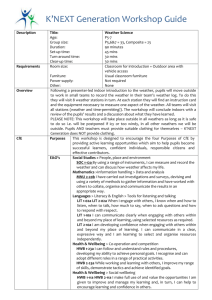
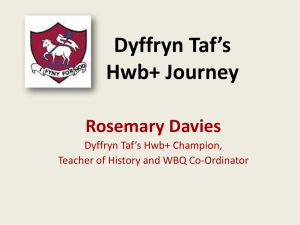
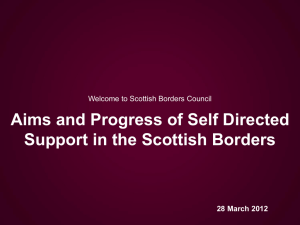
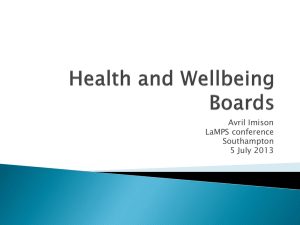
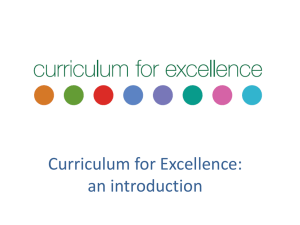
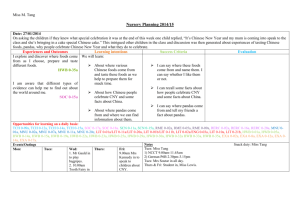

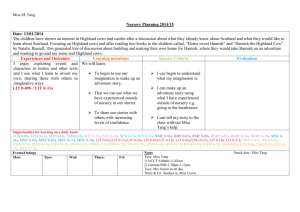
![afl_mat[1]](http://s2.studylib.net/store/data/005387843_1-8371eaaba182de7da429cb4369cd28fc-300x300.png)
